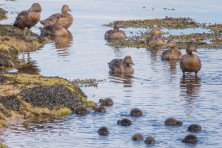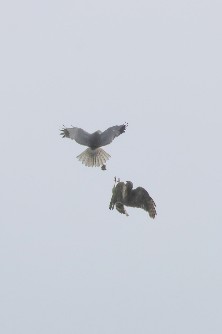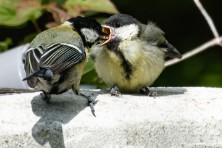June 2024
Bird Sightings



In comparison to last June, this June was colder. The mean temperature was almost four degrees lower than last June. The rainfall was similar to May with the wind again predominantly from a northerly direction. Conditions were challenging for insect eating birds in particular, birds trying to get on with breeding and species like warblers, pipits and hirundines.
Some observers have reported gardens full of young birds. There were many reports of fledged birds in gardens including unfamiliar looking young birds, like Goldfinch without the red face of the adult birds, and Robin with spots and no red breast. Among the familiar garden birds, Blackbird, Song Thrush, Chaffinch, Blue Tit, Great Tit and Dunnock seemed to be doing well. Most prolific of all seemed to be House Sparrow, with forty in Kingscross on 18th being one of the larger numbers. Also, there were many reports of numbers of Siskin and Goldfinch with young around, including seventeen Goldfinch in Shannochie on 14th and thirty Siskin in Largymore also on 14th. Again, it was encouraging to get reports of young Bullfinch, young Greenfinch and young Great Spotted Woodpecker from widespread locations. Fifteen Long-tailed Tit including young, in a garden in Pirnmill on 17th was a particular garden highlight.
Away from gardens there were many signs of breeding including, four Skylark singing over An Tunna on 1st, a pair of Mute Swan with six young in Corrie on 3rd, a family of Goldcrest in Brodick Country Park on 6th, around twenty occupied Sand Martin nests in Glen Catacol on 9th (much fewer than last year), a creche of nineteen Eider with eleven young in Kildonan on 11th, a female Mallard with six young at Port na Lochan on 12th, three recently fledged Great Spotted Woodpecker in Shedog on 13th, a flock of fifty Starling including young in Strathwillan on 19th, Woodcock roding over Lakin on 22nd, Common Gull with recently hatched young on the roof of council offices in Lamlash on 26th and Little Grebe with three young on Mossend Pond on 27th. Cuckoo, whose decreasing numbers are a cause for concern nationally, seems to be thriving on Arran.
The
breeding success of some raptors is linked to the vole cycle. Bumper years of
voles tend to be followed by a crash followed by a gradual build up followed by
a bumper year in a roughly four-year cycle. 2021 was a crash year with few
voles around. This year the vole population was low perhaps as a result of the
cold wet spring. Those licensed to
monitor Barn Owl and Short-eared Owl territories report a poor breeding season.
In June there were no reports of Corncrake, Nightjar, Quail and Wood Warbler. There were a few reports of other scarce summer visitors including; Tree Pipit on Dun Fionn on 7th, Whinchat in Glen Iorsa on 10th and Spotted Flycatcher in Glenashdale on 13th. Encouragingly Arctic Tern were on territory on Pladda.
Other highlights in a month with over one hundred species reported, included; twelve Gannet off Pladda on 1st, twenty-seven Sanderling at Drumadoon Point on 8th, two over-summering Whooper Swan at Cordon on 11th, thirty Manx Shearwater off Kildonan on 12th, one hundred Shag off Pladda also on 12th, a Fulmar at King’s Cave on 16th, two adult White-tailed Eagle in Machrie Bay on 28th plus the albino House Sparrow in Clachaig that featured in a previous Bird Note.
There were no June reports of Kingfisher and only one of Little Egret. That was at Cordon on 20th . It is anticipated that later in the summer both species will be reported on Arran, dispersing after breeding elsewhere. Also in July, look out for early signs of breeding being over for other birds this year. These could include the return of some Arctic breeding species to our shores, as they travel south. Already in June there were reports of four Turnstone in Blackwaterfoot on 25th and a Greenshank in Catacol Bay on 26th.
Finally remember July is the time when many birds, having raised their young, go about the process of renewing their feathers by moulting them. As birds are vulnerable when they are shedding flight feathers, they literally make themselves scarce. On any walk you may see fewer birds, but they are still around.


